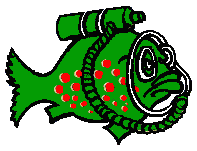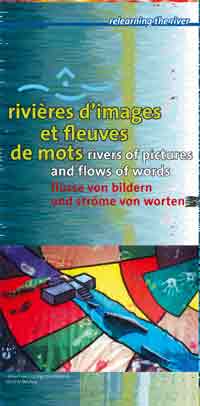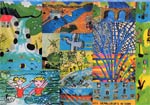|
|
"Rivers of pictures and flows of Words"
Relearning the river
an educational program created by European Rivers Network )
It promotes through the arts watershed awareness. Through our annual art and poetry contest and with the help of our educator's handbook, helps about 50-100 classes each year of the same watershed to begin exploring the natural and cultural history of their own river.
This program offers a multidisciplinary approach to bringing nature and art into the classroom. It invites students (from 4 to 16 year old) to explore throughout several expeditions their own watershed, discover its importance in their lives, and express what they've learned, felt and observed in words and images (painting 1m50x2m50 and or a poem).
All these paintings are composing a big exhibition which travels throughout the watershed to develop its inhabitants' watershed awareness.Top News
for more information and pictures go to the french version
or phone ERN European Rivers Network / SOS Loire Vivante Tel: 0033 (0)471055788 Fax: 0033 (0)471026099 e-mail: see www.sosloirevivante.org (contacte)
General Informations :
In 1997, Roberto Epple, ERNs Founder President ( ERN is a European Network of NGOs working for rivers protection) ERN set up, with it's regional Partner SOS Loire Vivante, an educational project on the Loire basin, "Rivers of pictures and flows of Words" . The project has bee inspired by the very succesfull project "River of Words", originally launched by the International Rivers Network in USA.
In France, the project was successfull with a large participation: over 14 500 children distributed on the 15 départements of the Loire river basin from 1997-2004, more then 30 exhibitions. For pictures and docs go to our french pages of the project.
In the same time, another project has been implemented on the Elbe riverbasin ( Czech Republic and Germany.) 180 schools distributed on the whole Elbe river approached the scientific aspects of the river (water analyses, measure of pollutions, biological indicators) in the framework of the educational project "Schools for a living Elbe" in cooperation with the DUH (Deutsche Umwelthilfe). This project is know a independent program of the Lebendige Elbe Project.
In 2003/2004 the "Rivers of pictures and flows of Words" project will be implemented on the Rhine River in by ERN France (European Rivers Network) cooperation with the other partners of the RhinNet Interreg Programm
The project is after years of experience, ready to be adapted for other River Basins. (under work : Rhone, Ebro, Danube).
It aims at developing, through art, children awareness of rivers ecological problems to prepare them to be the future citizens responsible for tomorrow's water.
The project takes the shape of a poetry and art contest for schools (from primary to high schools) of the whole Loire river basin.see also our presentation panels (engl/french)
"The river that wash away everything
is called violent
but noone accuse of violence
the banks that stemming it"
BrechtChildren are invited to explore their local river, their own spot of Loire, under its ecological and also cultural aspects, and to talk about it through a collective work of art, plastic or poetic.
To accompany them in this research, a pedagogical guide was conceived for this project, which mixes an emotional with an objective approach.
The project focuses on the suppression of boundaries, at all levels:
· between art and knowledge: to create is also to learn
· between different disciplines (the river is a thread between sciences, geography, history and literature)
· between ecological and social sciences concerns (the river is a natural environment but also a rich cultural world)Children are invited to explore their local river together with local actors (NGOs for environmental education, fishermen associations, artists, etc.), these local examples being the thread allowing to evoke all subjects, the result of this research being expressed through art. In this way, the artistic realization is supported by reality, which should appear in the work of art, the various works from the different local rivers therefore carrying knowledge of the basin.
One of the main preoccupations of the project is to ensure that children efforts won't be discredited. "Rivers of pictures and flows of Words" is a contest, but it is in the first place a mean to create a dialogue between the Loire of the Mont Gerbier de Jonc (the source) with the estuary, including all tributaries, as well as tributaries of tributaries. First, the collective work of art is the result of a work on environmental education. This work starts from the exploration of the river and go through the sharing of the results, a common reflection, the participation of everyone. The contest also name winners but we insist on the worth of the work of each class through a strategy of exhibition of all the works (exhibitions all along the Loire river, publications, online publishing).
The intention of the "Rivers of pictures and flows of Words" project is to integrate art as a way to knowledge and discovery of the world and of the environment. The invitation to the child to discover its "ecological address" helps him to make him/her realize he/she is a part of a whole, to which he/she is linked and that his/her actions have consequences on this whole. The respect for nature begins on the banks of your river… To experience this responsibility prepare the ground for future behaviours respectful of environment.
This "ecological address" allows the child to define him/herself within a natural entity based on the river and its tributaries. This helps him/her realize the necessity to better know and better protect the rivers. The contest, by developing the idea of belonging to the Loire basin, develops an ecological awareness: you have to protect your stream to protect the river downstream, the global health depends on the action of everyone on a local level. Therefore, whatever the town they come from, the pupils realized they belong to a whole, as a poem - written by children from Nantes and addressed to children upstream - can show : " Be careful not to pollute our river because we, at the estuary, we gather everything !"
Through artistic creation, a real education to environment is at work. To go from a practical study to an artistic production give children an opening … to their fantasy ; towards more autonomy and freedom to think … On another way, the work of art includes a part of reality … fantasy here is a vehicle allowing to translate reality in a richer, more global way.
The awareness that local heritage is a part of a wider heritage allows the child to realize what its place is in the community, which is made of a geological history, microclimates, specific fauna, flora and cultural traditions.The aim is that the child lives this responsibility in a concrete way, including him/her in an educational project worked out through a collaboration between the schools and the local actors of an area.
To take part in the contest is to take part in a dynamic of exchanges where everybody is telling, through its art, its river story while discovering the rivers of the others. Each work of art represents an interpretation of the local river heritage and the exhibition of the works is a way to re-form the basin in a symbolic manner. The exhibition "strategy" therefore allows to develop the children's work and gives all its dimension to art as a vehicle for communication and knowledge.The works of all the classes, once they are put together, create an artistic map of the basin … intended to travel along the river and its tributaries. The schools of the whole River basin put their works at the disposal of ERN for the itinerant exhibition. Everybody, children and adults, living along the river, are invited to consider their belonging to the basin and to discover the treasures and the diversity of its natural heritage.
The winning works are also presented on Internet.
The potential extensions of the project.They are numerous: exhibitions of the children's works together with those of local artists in various types of cultural places (local galleries, "Loire houses", etc.); operations showing the value of the river heritage (local history, ethnography); artistic events; theatrical events on the theme of the river; plastic creations born from this dynamic around the river heritage: installations, events on natural sites, etc.
The impact of the project: methods of analysis.The impact of the project can be analysed through the number of participants,
but also through the quality of the collective works of art expressing the growing awareness of children:- which can be read in the artistic work : the jury noted that the works were the results of a real research : references to fauna and flora, pollution, elements of the local river.
- which can be read in the initiatives born from those works … the school teachers revealed that a deep work on ecological awareness was present during all the contest, going along an active, creative and emotional participation of children.The participating classes are invited to describe their approach in a systematic way : from which angle did they explore the river, which tools did they use, what were the concrete results and how those have been brought into play in the artistic creation. A summary of their discoveries has to be joined to their artistic work and this document is presented to the jury when the winners are selected.
The pedagogical strategy around the creation are numerous and varied : to read a map; to search for documentation; to go out on the ground with local groups, interviews of local actors (fishermen, farmers); visits of sites, of water treatment units; scientific analysis, walks just meant to hear and
feel …The artistic work is mixed with a research work combining scientific as well as artistic preoccupations: for example to gather elements in nature for the artistic creation implies observation, identification and learning … To search for indications (for example, to determine which fish species are living in a river) will make the child become familiar with documentary research or interview methods (ethnology, sociology, journalism) with its varying reliability (necessity to decipher, to match up with other sources of information). Knowledge is nourished through different ways: for example, the underlying impregnation born when all the readings of the year were on the theme of the river.
Allowing them to appropriate the project, the "project pedagogy" leads the pupils to the desire for knowledge. The interest of the project seems to be "self-feeding": the children testify their wish to know more about the theme, while the teachers take part to the contest several years in a row to extend their work. The contest often generates other activities: a decoration of a river beach with a mosaic of pebbles, a rearing of tadpoles …
In a perspective of pedagogical support, of an assessment of the project and also to create a network linking all the educational projects on the European basins, a pedagogical meeting took place in the Château de la Source on the 12th and 13th of June 1999. This event was the opportunity for different actors working on the Loire river to meet (Water Agency, Maison de Loire, environmental NGOs, inspectors of schools, etc). They shared their experience with teachers from the Loire basin and with German and Czech teachers working on the Elbe basin.
Since its last edition, an assessment form about our programme was given to all the teachers to put in light the positive and the negative. This assessment is very clear and shows that the richness and the originality of our pedagogical guide are really appreciated by teachers.
The project, renewed each year, is a long term project. With the creation of a growing network of actors and the appearance of local and as well as cross-country dynamics (inter-basins exchanges), the project will inevitably grow. Continuity is an important aspect of the project, the results of the work with the pedagogical guide have to be communicated, exchanged and shared to stimulate a dynamic around the basin concept as well as actions for environmental protection.




